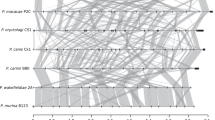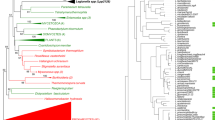Abstract
Pneumocystis carinii pneumonia is the most common opportunistic infection in AIDS1, and accounts for significant morbidity and mortality in these and other immunocompromised patients2. P. carinii is a eukaryotic microorganism of uncertain taxonomy that can infect numerous mammalian hosts. Developing from a small, unicellular 'trophozoite' into a 'cyst' containing eight 'sporozoites', its life cycle superficially resembles those seen both in the Protozoa and Fungi. Morphological and ultrastructural observations have lead some investigators to conclude that the organism is a protozoan3–6, while others have felt that it more closely resembles a fungus7–9. Phylogenetic relationships can be inferred from comparisons of macromolecular sequences10. Small subunit ribosomal RNAs (16S-like rRNAs) are well-suited for this purpose because they have the same function in all organisms and contain sufficient information to estimate both close and distant evolutionary relationships. Phylogenetic frameworks based upon such comparisons reveal that the plant, animal and fungal lineages are distinct from the diverse spectrum of protozoan lineages11. In this letter, phylogenetic analysis of Pneumocystis 16S-like rRNA demonstrates it to be a member of the Fungi.
This is a preview of subscription content, access via your institution
Access options
Subscribe to this journal
Receive 51 print issues and online access
$199.00 per year
only $3.90 per issue
Buy this article
- Purchase on Springer Link
- Instant access to full article PDF
Prices may be subject to local taxes which are calculated during checkout
Similar content being viewed by others
References
Mills, J. Rev. Infect. Dis. 8, 1001–1011 (1986).
Kovacs, J. A. et al. Ann. intern. Med. 100, 663–671 (1984).
Jirovec, O. & Vanek, J. Zentbl. Path. Anat. 94, 499–517 (1956).
Yoneda, K., Walzer, P. D., Richey, C. S. & Birk, M. G. Expl. Parasit. 53, 68–76 (1982).
Ham, E. K., Greenberg, S. D., Reynolds, R. C. & Singer, D. B. Expl molec. Path. 14, 363–372 (1971).
Campbell, W. G. Archs Path. 93, 312–324 (1972).
Csillag, A. Acta microbiol. hung. 4, 1–8 (1957).
Vavra, J. & Kucera, K. J. Protozool. 17, 463–483 (1970).
ul Haque, A., Plattner, S. B., Cook, R. T. & Hart, M. N. Am. J. clin. Path. 87, 504–510 (1987).
Fitch, W. M. & Margoliash, E. Science 155, 279–284 (1967).
Sogin, M. L., Elwood, H. J. & Gunderson, J. H. Proc. natn. Acad. Sci. U.S.A. 83, 1383–1387 (1986).
Elwood, H. J., Olsen, G. J. & Sogin, M. L. Molec. Biol. Evol. 2, 399–410 (1985).
Gunderson, J. H., Elwood, H. J., Ingold, A., Kindle, K. & Sogin, M. L. Proc. natn. Acad. Sci. U.S.A. 84, 5823–5827 (1987).
Riley, L. K., Marshall, M. E. & Coleman, M. S. DNA 5, 333–337 (1986).
Collins, M. L. & Hunsaker, W. R. Analyt. Biochem. 151, 211–224 (1985).
Gill, V. J. et al. J. clin. Microbiol. 25, 1837–1840 (1987).
Frenkel, J. K., Good, J. T. & Schults, J. A. Lab. Invest. 15, 1559–1577 (1966).
Walzer, P. D. & Rutledge, M. E. J. infect. Dis. 142, 449 (1980).
Walzer, P. D. & Linke, M. J. J. Immunol. 138, 2257–2265 (1987).
Hughes, W. T. J. infect. Dis. 145, 824–848 (1982).
Hendley, J. O. & Weller, T. H. Proc. Soc. exp. Biol. Med. 137, 1401–1404 (1971).
Rippon, J. W. Medical Mycology 2nd edn (Saunders, Philadelphia, 1981).
Desjardins, R. E. in Handbook of Experimental Pathology 64 (ed. G. H. Hitchings) 411–440 (Springer, Berlin, 1983).
Kovacs, J. A. et al. J. Immunol. 140, 2023–2031 (1988).
Cathala, G. et al. DNA 2, 329–335 (1983).
Maniatis, T., Fritsch, E. F. & Sambrook, J. Molecular Cloning: A Laboratory Manual (Cold Spring Harbor Press, New York, 1981).
Torczynski, R. M., Fuke, M. & Bollon, A. P. DNA 4, 282–291 (1985).
Torczynski, R. M., Bollon, A. P. & Fuke, M. Nucleic Acids Res. 11, 4879–4890 (1983).
Messing, J., Carlson, J., Hagen, G., Rubenstein, I. & Olesen, A. DNA 3, 31–40 (1984).
Sogin, M. L., Miotto, K. & Miller, L. Nucleic Acids Res. 14, 9540 (1986).
Rubstov, P. M. et al. Nucleic Acids Res. 8, 5779–5894 (1980).
Gunderson, J. H., McCutchan, T. F. & Sogin, M. L. J. Protozool. 33, 525–529 (1986).
McCarroll, R., Olsen, G. J., Stahl, Y. D., Woese, C. R. & Sogin, M. L. Biochemistry 22, 5858–5868 (1983).
Caroni, P., Carlson, S. S. Schweitzer, E. & Kelly, R. B. Nature 314, 441–443 (1985).
Author information
Authors and Affiliations
Rights and permissions
About this article
Cite this article
Edman, J., Kovacs, J., Masur, H. et al. Ribosomal RNA sequence shows Pneumocystis carinii to be a member of the Fungi. Nature 334, 519–522 (1988). https://doi.org/10.1038/334519a0
Received:
Accepted:
Published:
Issue Date:
DOI: https://doi.org/10.1038/334519a0
This article is cited by
-
Pneumocystis jirovecii pneumonia: a case report
Journal of Medical Case Reports (2024)
-
Efficacy of initial caspofungin plus trimethoprim/sulfamethoxazole for severe PCP in patients without human immunodeficiency virus infection
BMC Infectious Diseases (2023)
-
Comparison of different microbiological procedures for the diagnosis of Pneumocystis jirovecii pneumonia on bronchoalveolar-lavage fluid
BMC Microbiology (2022)
-
Pneumocystis-jirovecii-Pneumonie – eine opportunistische Infektion im Wandel
Der Internist (2019)
Comments
By submitting a comment you agree to abide by our Terms and Community Guidelines. If you find something abusive or that does not comply with our terms or guidelines please flag it as inappropriate.



